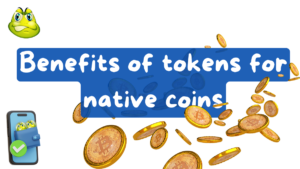Tokens and native coins in the blockchain ecosystem have a mutually beneficial and often complementary relationship. Native coins are the primary currency of a blockchain (for example, ETH for Ethereum or BTC for Bitcoin), while tokens are digital assets created on top of that blockchain. Here are the benefits of tokens for native coins in a blockchain ecosystem:
1. Increasing Utility and Demand for Native Coins
- Tokens usually require native coins to pay transaction fees (gas fees). For example, on Ethereum, users need to pay gas fees using ETH to transfer ERC-20 tokens.
- The more tokens and applications used on the blockchain, the higher the demand for native coins, which can increase their value.
2. Encouraging Ecosystem Development
- Tokens allow developers to create various types of decentralized applications (dApps) on the blockchain, such as DeFi (Decentralized Finance), NFTs, games, and others.
- As more tokens and projects emerge in the ecosystem, this increases network activity and adoption, which contributes to the growth of the value and popularity of native coins.
3. Stimulating Liquidity and Financial Markets
- Tokens, especially in the DeFi ecosystem, enable a variety of financial services such as staking, yield farming, and lending, all of which use the native coin as the primary liquidity.
- These activities drive the liquidity and trading volume of the native coin, which in turn can increase the stability and growth of the asset’s value.
4. Encouraging Community Participation and Decentralization
- Governance tokens allow the community to participate in decision-making regarding projects or protocols in the ecosystem. These governance activities often use the native coin as a means of purchasing or acquiring the token.
- By actively engaging the community through governance tokens, the blockchain ecosystem can become more decentralized and widely supported, which strengthens the value and trust in the native coin.
5. Financial Product Innovation and Diversification
- Tokens are often used to create new products and services on top of the blockchain, such as stablecoins, NFTs, or tokens that represent real-world assets. These products provide additional utility to the native coin and enrich its ecosystem.
- By expanding the range of applications supported by the blockchain, tokens help increase diversification and innovation, which can contribute to the long-term adoption and value of native coins.
6. Increasing Security and Scalability Through Staking
- Some blockchains that use the Proof of Stake (PoS) model allow tokens to be staked with native coins as the basis for network security. This strengthens the overall network and increases the stability of the native coin.
- Staking programs involving tokens also increase the number of native coins locked in the network, which reduces the supply in the market and potentially increases the value of the native coin.
7. Use in Payment Systems and On-Chain Economies
- Tokens are often used to create economies within decentralized applications such as blockchain games or NFT marketplaces. All transactions within these economies typically require native coins for gas fees, increasing the circulation of native coins.
- As these token-based economies grow, the use and adoption of native coins as a means of payment on the network will increase.
Conclusion
The benefits of tokens for native coins in the blockchain ecosystem are significant. Tokens not only increase the usability and demand of native coins, but also drive development, liquidity, community participation, and innovation within the blockchain network. This synergistic relationship strengthens the overall ecosystem, drives value growth, and increases long-term adoption for native coins.




